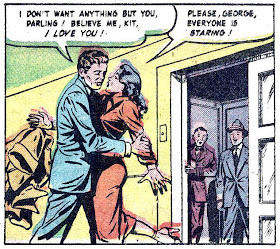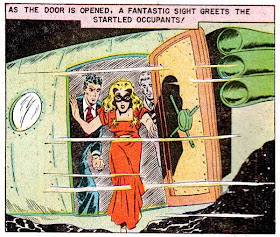Flash Lightning was born of the “mysterious East.” We find out the bare bones of his origin on page 1 of his introduction in Sure-Fire Comics #1 (1940), published by Ace. He was trained in Egypt. Whatever gave him his powers, by 1940 superheroes were basically old hat and the origin was just a means to an end. And the end was action, action, action! That’s exactly what happens to Flash as he goes right to work rescuing a beautiful girl’s dad from a life of slavery.
The Grand Comics Database lists Robert Turner as writer. There is an indexer note that the story is based on the May 1938 pulp magazine, Captain Hazzard. A lack of originality in the story is matched by swipes from Alex Raymond’s Flash Gordon by artist Harry Lucey. A year or so later Flash’s name became Lash Lightning, and while I can’t find official information on the reason for the change, it’s likely DC Comics’ character, the Flash, had something to do with it. Another name change came with the comic book title, which after four issues as Sure-Fire Comics became Lightning Comics. Like many other superheroes born in the wake of Superman, Flash/Lash Lightning disappeared shortly after the end of the war. Had I been in charge of him in 1946 I might have taken away the super powers and made Lash Lightning a private eye with a whip. He couldn’t be a cowboy, because Lash LaRue was already whipping up bad guys in the Western B-movies in which he starred.
Sunday, June 30, 2013
Friday, June 28, 2013
Number 1392: Advertising for love
The story today is of mid-century advertising boss Katherine Laurel and her rocky road to romance with subordinate, then rival, George Dunn. It's interesting that Katherine, despite her weakness for love (which happens to all of us), is presented as a successful business owner and career woman. That wasn’t the norm in real life-1951 when the story was published in Charlton’s True Life Secrets #2. I know the ending is sort of a cop-out, but it is of its time, and you can cherry-pick the positives in the tale for young female readers.
Wednesday, June 26, 2013
Number 1391: Kidnapped to the future!
Blonde Phantom, alter ego of mousy secretary Louise Grant, lusts after her boss, Mark. But like many comic book masqueraders, she finds herself in a love triangle with herself. Tsk tsk. My advice to Louise is to tell Mark — don’t keep secrets; they lead to mistrust. (Short lecture over.)
Louise and Mark are kidnapped by a group of future men who put them in a zoo to be studied by the thirtieth century citizens. If Louise had been a guy she would have just used brute force and whupped on the kidnapers. But Blonde Phantom uses her brain to overcome her adversaries...and she does it all in an evening dress and high heels. This entertaining story, from Marvel’s Blonde Phantom #21 (1949) is credited by the Grand Comics Database with art by Al Gabriele and Harry Sahle.
Louise and Mark are kidnapped by a group of future men who put them in a zoo to be studied by the thirtieth century citizens. If Louise had been a guy she would have just used brute force and whupped on the kidnapers. But Blonde Phantom uses her brain to overcome her adversaries...and she does it all in an evening dress and high heels. This entertaining story, from Marvel’s Blonde Phantom #21 (1949) is credited by the Grand Comics Database with art by Al Gabriele and Harry Sahle.
Monday, June 24, 2013
Number 1390: “All that glitters...”
For a time in the 1950s comic artist John Forte’s work could be found prominently in ACG titles. He went from there to DC where he did the Bizarro World stories in Adventure Comics, written by Jerry Siegel. He then became the first artist for the Legion of Superheroes. He died young in 1965.
I never really saw him as a superhero artist, although his Bizarro stories are some of my favorites of the era. My affection for Forte is for his work on mystery and supernatural. This particular story, “The Glittering Nightmare,” is credited to Forte and writer Shane O’Shea (actually ACG editor Richard E. Hughes). It has a scientist obsessed with a project that ruins his marriage and an alien lifeform taking on earthly shapes, reminding us of Invasion of the Body Snatchers. I showed this story in the early days of this blog, but these are my new and improved scans.
From Forbidden Worlds #76 (1959):
Some pre-Comics Code Forte here. Just click the picture.
I never really saw him as a superhero artist, although his Bizarro stories are some of my favorites of the era. My affection for Forte is for his work on mystery and supernatural. This particular story, “The Glittering Nightmare,” is credited to Forte and writer Shane O’Shea (actually ACG editor Richard E. Hughes). It has a scientist obsessed with a project that ruins his marriage and an alien lifeform taking on earthly shapes, reminding us of Invasion of the Body Snatchers. I showed this story in the early days of this blog, but these are my new and improved scans.
From Forbidden Worlds #76 (1959):
Some pre-Comics Code Forte here. Just click the picture.
Sunday, June 23, 2013
Number 1389: Enter Albert and Pogo
Any ardent Pogo fan can tell you Walt Kelly’s familiar character did not spring forth from his creator’s forehead fully formed. Rather he was developed over time. As you can see in this, the first appearance of both Albert Alligator and Pogo Possum in Animal Comics #1 (1942), they were hardly recognizable as to what they would someday become. No matter. The Kelly humor is here, and while the Pogo characters went through an evolution, Kelly was as talented in his beginnings as he was at the end of his career, which came with his death in 1973.
I’m also showing another Kelly strip from the same issue of Animal Comics. “Muzzy and Ginger,” is a more typical funny animal strip.
I’m also showing another Kelly strip from the same issue of Animal Comics. “Muzzy and Ginger,” is a more typical funny animal strip.
































































